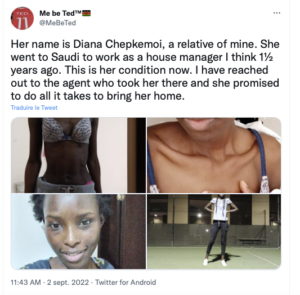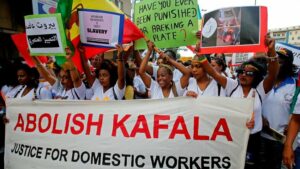Share
The Gulf states are known to be a prime destination for domestic workers due to high demand in those countries and their economical wealth.
We count 75.6 million domestic workers across the globe, 76 per cent are women who come from the poorest regions of the world. 2.4 million of domestic workers are located in the gulf states (ITUC,2017) and the Sub-Saharan African domestic workers who are mainly women represents a significant portion. Due to the rapid growth of the population in sub-Saharan Africa which surpassed 1.2 billion in 2018 (African union, 2015) the labor market became unable to contain the huge number of job seekers. Working as a domestic worker in the middle east for women in particular became one of the solutions to overcome poverty despite the potential abuse, racism and bad working conditions.
The racialization of the sub-Saharan women domestic workers:
In the context of the Middle East, unlike the west where racism is exercised by the dominant and majority race over a minority with different ethnicities, it is the Arab minority that exercises a form of racism over a majority composed exclusively of migrant workers. The difference in treatment of migrant workers reveals a hierarchization based on the domination of one race over another. The western worker occupies more prestigious jobs in various fields, while African workers, for example, are limited to work in the fields of construction, and domestic work, and are considered low-skilled workers. In the domestic work sector, women who represent the vast majority of domestic workers are also subject to classification based on race. Working under the kafala system, the nationality of these women is taken into consideration by the employer in the process of recruitment, where a women domestic worker from the Philippines for example is regarded as clean, literate, English-speaking, and good with children, the sub-Saharan domestic worker is viewed as uneducated and stubborn.
This racial differentiation has also an impact on the salaries that varies depending on women’s nationality, where a south Asian domestic worker is likely to be paid more than the sub-Saharan woman. This concept of racialization that is considered degrading and humiliating leaves the sub-Saharan women more vulnerable and more subjected to exploitation as they are considered the least desired domestic workers. the stories of thousands of sub-Saharan women domestic workers prove this hypothesis and expose the exploitative and abusive nature of the kafala system.
Diana Chepkemoi, from a domestic worker to a modern slave
Her story is not singular but she caught the attention of thousands of people around the world and obliged the Kenyan government to intervene to save her life.
Last September, a tweet from one of her relatives showing the physical transformation of Diana after being a domestic worker for six months in Saudi Arabia shed the light on the horrible situation she endured. The hashtag #LetsBringDianaHome made her case more visible to local authorities and led to her rescue.
Diana was recruited through a local recruitment agency as a domestic worker in Saudi Arabia. In her testimony once she went back home, Diana revealed that she was no longer treated as a human being and faced multiple types of abuse such as working in different homes, not receiving her paycheck, and constantly being told that she was not doing a good job as a form of psychological torture. Unfortunately, Diana’s case is just a small example amongst many others who are still working as domestic workers in the middle east region. The absence of legal protection, social isolation and the lack of personal agency under the kafala system put those women at high risk of enslavement and exploitation.




Average Rating